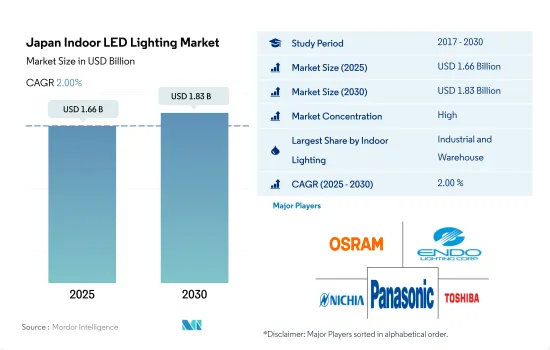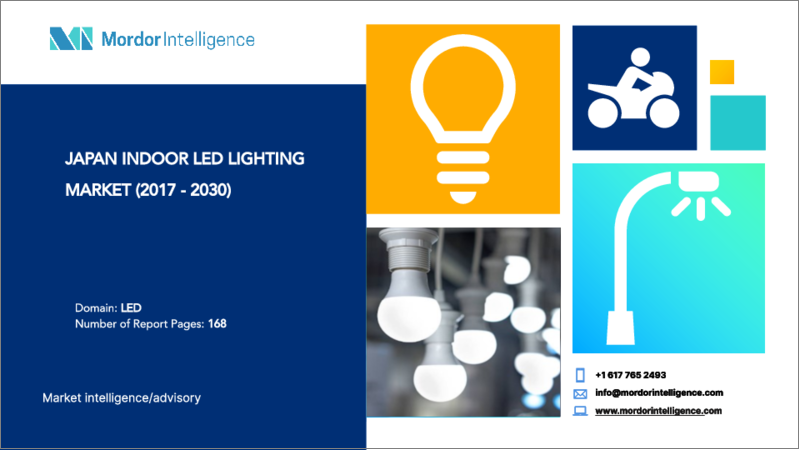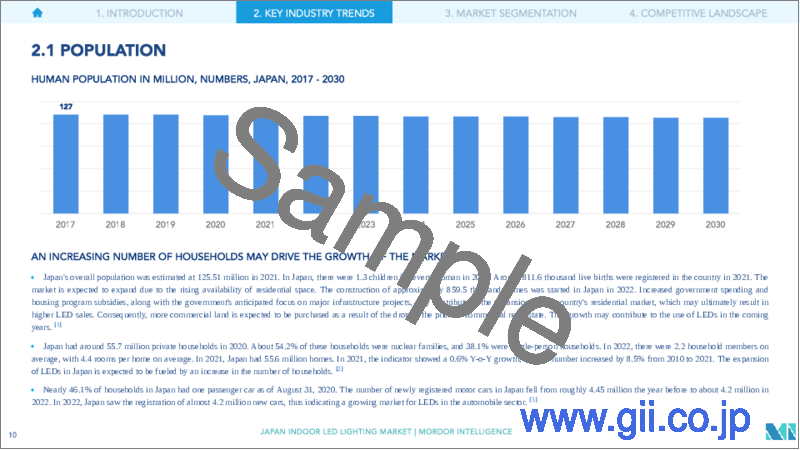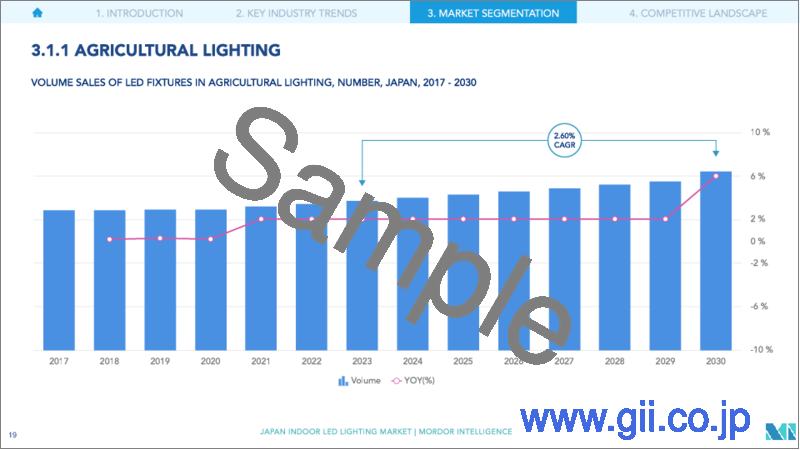|
|
市場調査レポート
商品コード
1683953
日本の屋内用LED照明:市場シェア分析、産業動向・統計、成長予測(2025年~2030年)Japan Indoor LED Lighting - Market Share Analysis, Industry Trends & Statistics, Growth Forecasts (2025 - 2030) |
||||||
カスタマイズ可能
適宜更新あり
|
|||||||
| 日本の屋内用LED照明:市場シェア分析、産業動向・統計、成長予測(2025年~2030年) |
|
出版日: 2025年03月18日
発行: Mordor Intelligence
ページ情報: 英文 168 Pages
納期: 2~3営業日
|
全表示
- 概要
- 目次
日本の屋内用LED照明市場規模は、2025年に16億6,000万米ドルと推定され、2030年には18億3,000万米ドルに達すると予測され、予測期間(2025-2030年)のCAGRは2.00%で成長する見込みです。

産業部門と商業オフィスの需要開拓が市場成長を牽引
- 金額シェアでは、2023年には産業・倉庫分野が過半数を占め、商業分野がこれに続きます。2019年第1四半期の日本経済は予想以上に拡大しました。日本の経済成長率は年率1.8%でした。このため、産業・商業分野を中心に、あらゆる分野でLED照明の需要が大きく伸びた。COVID-19時代はeコマース商品の需要を増加させ、主にB2CにおけるLED照明の需要増加につながりました。現在、市場の需要は両分野で増加しています。2022年には供給が増加し、LEDの低価格化が進みます。2022年第4四半期の日本の商業用不動産価格指数は146.6となり、前期の155.4ポイントから低下しました。
- 数量シェアでは、商業地が大半を占め、次いで住宅地が第2位となっています。2023年の半年間で、新規供給は2022年の3倍になると予想され、東京都心5区のグレードAオフィスでは10年間の過去平均の約1.5倍となります。2020年のパンデミック発生に伴い、住宅地価は2021年に0.5%下落しました。しかし、長期的な動向にもかかわらず、国内の大都市圏における住宅需要は引き続き旺盛です。札幌市は2023年に11.8%の成長率を示し、主要な住宅需要が見込まれます。
- 市場開拓の面では、農業と産業用照明の需要が大きく伸びると予想されます。面積の面では、2020年には日本の国土のわずか12%しか農業用地がありませんでした。来年には、この数字はさらに減少し、商業用温室の普及につながり、LEDのさらなる需要に対応すると予想されます。
日本の屋内用LED照明市場動向
高齢者の増加と人口減少が不動産の成長を妨げると予想される
- 日本では2022年に約25万3,300件の集合住宅が着工されます。持家開発着工件数は前年比11.3%減。住宅の新築は毎年行われているが、伸び率は低下しています。この動向は、物件数の増加が国内でのLED普及を後押しすることを示唆しています。日本の可処分所得は他の開発途上国に比べて高いです。例えば、2022年のインドの可処分所得は2301.4米ドル、次いでベトナムの3716.8米ドル、中国の12,732.5米ドルです。日本の1人当たり所得は、2021年12月の39,916.1米ドルに対し、2022年12月には33,911.2米ドルに達しました。2021年と比べると、2022年の日本の経済成長は鈍化し、経済活動は商品価格の高騰、供給サイドの制約、COVID-19パンデミックの影響によって影響を受け、可処分所得は減少しました。
- 日本の人口は、死亡者の増加と出生率の低下により12年連続で減少しました。2022年の人口は1億2,449万人で、前年から55万6,000人減少しました。この減少は、今後平均世帯人数が減少し、多くの持ち家が飽和状態になることを示唆しています。2017年5月、東京都はLED電球へのシフトを通じて家庭の省エネ運動を促進するキャンペーンを開始しました。都民が白熱電球2個以上を最寄りの家電量販店に持参すると、LED電球1個と交換してもらえます。このような事例は、今後数年間、日本におけるLED照明の需要を押し上げると予想されます。
住宅・商業施設の建設増加、スマートシティプロジェクト、政府キャンペーンがLED照明の使用を促進
- 2021年度の日本の産業部門と商業部門の合計エネルギー消費量は約7.8エクサジュールでした。同年度の住宅部門のエネルギー消費量は約1.7エクサジュールでした。日本経済は建設部門に大きく依存しており、2021年度のGDPに5.5%寄与しています。中央新幹線の建設や、2025年の大阪万博で計画されているその他の建物の建設も、同様の影響を与えると推定されています。5年間の加速戦略の一環として、政府は1,200億米ドル以上の投資を計画しています。建設の増加は、商業および住宅市場の需要を押し上げると予想され、LED市場に利益をもたらすと予想されます。
- 商業部門の電力需要は、営業時間中(10~12時間)が最も高いです。産業部門の電力使用量は、1日(24時間)を通して変動しない傾向があります。住宅部門の電力需要は、約4~6時間変動する傾向があります。ミネベアミツミという日本の企業が、2020年に大阪でスマートLED街灯計画を開始しました。このスマートシティプロジェクトは、道路周辺の環境、交通量、道路上の浸水などをチェックすることを目的としています。これは、日本のLED市場の成長に拍車をかけると期待されています。
- 東京都は2017年、省エネのために家庭でのLED電球への切り替えを奨励するキャンペーンを開始しました。このキャンペーンは、地元の人々にLEDランプの省エネ機能を活用するよう促しました。このプログラムは国の電力消費を削減し、LED照明の採用を促進することが期待されています。
日本の屋内用LED照明産業の概要
日本の屋内用LED照明市場はかなり統合されており、上位5社で76.64%を占めています。この市場の主要企業は以下の通りです。 ams-OSRAM AG, Endo Lighting Corporation, Nichia Corporation, Panasonic Holdings Corporation and Toshiba Corporation(sorted alphabetically).
その他の特典
- エクセル形式の市場予測(ME)シート
- 3ヶ月のアナリストサポート
目次
第1章 エグゼクティブサマリーと主な調査結果
第2章 レポートのオファー
第3章 イントロダクション
- 調査の前提条件と市場定義
- 調査範囲
- 調査手法
第4章 主要産業動向
- 人口
- 一人当たり所得
- LEDの総輸入量
- 照明の電力消費量
- 世帯数
- LED普及率
- 園芸面積
- 規制の枠組み
- 日本
- バリューチェーンと流通チャネル分析
第5章 市場セグメンテーション
- 屋内照明
- 農業用照明
- 商業照明
- オフィス
- 小売
- その他
- 産業・倉庫
- 住宅
第6章 競合情勢
- 主要な戦略動向
- 市場シェア分析
- 企業情勢
- 企業プロファイル(世界レベルの概要、市場レベルの概要、主要な事業セグメント、財務、従業員数、主要情報、市場ランク、市場シェア、製品・サービス、最近の動向分析を含む)
- ams-OSRAM AG
- Endo Lighting Corporation
- EVERLIGHT ELECTRONICS CO., LTD.
- Iris Ohyama Co., Ltd.
- Lumileds Holding B.V.
- Nichia Corporation
- ODELIC CO., LTD
- Panasonic Holdings Corporation
- Toshiba Corporation
- Up-shine Lighting Co.,Limited
第7章 CEOへの主な戦略的質問
第8章 付録
- 世界の概要
- 概要
- ファイブフォース分析フレームワーク
- 世界のバリューチェーン分析
- 市場力学(DROs)
- 情報源と参考文献
- 図表一覧
- 主要洞察
- データパック
- 用語集
The Japan Indoor LED Lighting Market size is estimated at 1.66 billion USD in 2025, and is expected to reach 1.83 billion USD by 2030, growing at a CAGR of 2.00% during the forecast period (2025-2030).

Increasing development in the industrial sector and commercial office demand states to drive market growth
- In terms of value share, in 2023, the industrial and warehouse segment accounts for a majority share, followed by commercial. Japan's economy expanded more than expected in the opening quarter of 2019. Japan's economy grew at an annual rate of 1.8%. This has led to a major demand for LED lighting in all sectors, mainly in the industrial and commercial segments. The COVID-19 era increased the demand for e-commerce goods, leading to more demand for LED lighting, majorly in B2C. Currently, the market demand is increasing for both sectors. In 2022, the supply increased, leading to low LED pricing. In Q4 2022, the commercial property price index for retail properties, warehouses, factories, apartment buildings, and commercial and industrial land in Japan stood at 146.6, down from 155.4 points in the previous quarter.
- In volume share, commercial accounts for the majority of the share, and then residential stands at the second spot. Over the next six months in 2023, new supply is expected to triple from 2022, at around 1.5 times higher than the 10-year historical average in Tokyo Central 5 Wards Grade A office. With the onset of the pandemic in 2020, residential land prices plunged 0.5% in 2021. However, despite the long-term trend, housing demand remained strong in the country's metropolitan areas. Sapporo is expected to have major residential demand, having an 11.8% growth rate in 2023.
- In terms of development, the market is expected to see major demand growth in agriculture and industrial lighting. In terms of area, only 12% of Japan's land was dedicated to agriculture in 2020. In the coming year, this number is expected to decrease further, leading to the penetration of commercial greenhouses, which will cater to more demand for LEDs.
Japan Indoor LED Lighting Market Trends
Increasing number of elderly people and the decreasing population are expected to hinder the growth of real estate
- In Japan, the construction of owned housing complexes began on about 253.3 thousand projects in 2022. The number of owner-occupied home development starts fell by 11.3% from the previous year. The new house construction has been happening every year, but the growth percentage has declined. This trend suggests that the increasing number of properties is expected to boost LED penetration in the country. Japan's disposable income is high compared to other developing nations. For instance, in 2022, India's disposable income was USD 2301.4, followed by Vietnam at USD 3716.8 and China at USD 12,732.5, resulting in rising spending power of individuals and more money being spent on new residential spaces. Japan's per capita income reached USD 33,911.2 in December 2022 compared to USD 39,916.1 in December 2021. Compared to 2021, disposable income declined as Japan's economic growth slowed in 2022, with economic activity being affected by high commodity prices, supply-side constraints, and the impact of the COVID-19 pandemic.
- Japan's population has declined for the 12th year in a row due to increased deaths and declining birth rates. In 2022, there were 124.49 million people, a decrease of 556,000 from the previous year. This decline suggests that the average household size is expected to decrease in the coming years, leading to a saturation point for a number of house owners. In May 2017, the Tokyo Metropolitan Government (TMG) launched a campaign to promote the energy-saving movement among households through a shift to LED bulbs. Residents of Tokyo who bring two or more incandescent bulbs to their local home appliance store will receive one LED bulb in exchange. Such instances are expected to boost the demand for LED lighting in the country in the coming years.
Rise in residential and commercial construction, smart city projects, and government campaigns promote the use of LED lights
- The combined energy consumption of Japan's industrial and commercial sectors in FY 2021 was roughly 7.8 exajoules. The residential sector consumed approximately 1.7 exajoules of energy in the same year. The Japanese economy relies heavily on the construction sector, contributing 5.5% to the country's GDP in 2021. It is estimated that the construction of the Chuo Shinkansen maglev line and other buildings planned for the Osaka World Expo 2025 will have a similar impact. As part of its five-year acceleration strategy, the government plans to invest over USD 0.12 trillion. The rise in construction is expected to boost demand in the commercial and residential markets, which is anticipated to benefit the LED market.
- Electricity demand in the commercial sector is the highest during operating business hours, which are 10-12 hours. Electricity use in the industrial sector tends not to fluctuate throughout the day (24 hours). Electricity demand in the residential sector tends to vary by about four to six hours. A Japanese company called Minebea Mitsumi launched a smart LED street lighting scheme in Osaka in 2020. The smart city project aims to check the environment around the roads, traffic volume, and flood water on the roads. This is expected to fuel the country's growing LED market.
- The Tokyo Metropolitan Government started a campaign in 2017 to encourage families to switch to LED bulbs to save energy. The campaign encouraged locals to take advantage of the energy-saving features of LED lamps. This program is expected to reduce the nation's electricity consumption and encourage the adoption of LED lighting.
Japan Indoor LED Lighting Industry Overview
The Japan Indoor LED Lighting Market is fairly consolidated, with the top five companies occupying 76.64%. The major players in this market are ams-OSRAM AG, Endo Lighting Corporation, Nichia Corporation, Panasonic Holdings Corporation and Toshiba Corporation (sorted alphabetically).
Additional Benefits:
- The market estimate (ME) sheet in Excel format
- 3 months of analyst support
TABLE OF CONTENTS
1 EXECUTIVE SUMMARY & KEY FINDINGS
2 REPORT OFFERS
3 INTRODUCTION
- 3.1 Study Assumptions & Market Definition
- 3.2 Scope of the Study
- 3.3 Research Methodology
4 KEY INDUSTRY TRENDS
- 4.1 Population
- 4.2 Per Capita Income
- 4.3 Total Import Of Leds
- 4.4 Lighting Electricity Consumption
- 4.5 # Of Households
- 4.6 Led Penetration
- 4.7 Horticulture Area
- 4.8 Regulatory Framework
- 4.8.1 Japan
- 4.9 Value Chain & Distribution Channel Analysis
5 MARKET SEGMENTATION (includes market size in Value in USD and Volume, Forecasts up to 2030 and analysis of growth prospects)
- 5.1 Indoor Lighting
- 5.1.1 Agricultural Lighting
- 5.1.2 Commercial
- 5.1.2.1 Office
- 5.1.2.2 Retail
- 5.1.2.3 Others
- 5.1.3 Industrial and Warehouse
- 5.1.4 Residential
6 COMPETITIVE LANDSCAPE
- 6.1 Key Strategic Moves
- 6.2 Market Share Analysis
- 6.3 Company Landscape
- 6.4 Company Profiles (includes Global level Overview, Market level overview, Core Business Segments, Financials, Headcount, Key Information, Market Rank, Market Share, Products and Services, and analysis of Recent Developments)
- 6.4.1 ams-OSRAM AG
- 6.4.2 Endo Lighting Corporation
- 6.4.3 EVERLIGHT ELECTRONICS CO., LTD.
- 6.4.4 Iris Ohyama Co., Ltd.
- 6.4.5 Lumileds Holding B.V.
- 6.4.6 Nichia Corporation
- 6.4.7 ODELIC CO., LTD
- 6.4.8 Panasonic Holdings Corporation
- 6.4.9 Toshiba Corporation
- 6.4.10 Up-shine Lighting Co.,Limited
7 KEY STRATEGIC QUESTIONS FOR LED CEOS
8 APPENDIX
- 8.1 Global Overview
- 8.1.1 Overview
- 8.1.2 Porter's Five Forces Framework
- 8.1.3 Global Value Chain Analysis
- 8.1.4 Market Dynamics (DROs)
- 8.2 Sources & References
- 8.3 List of Tables & Figures
- 8.4 Primary Insights
- 8.5 Data Pack
- 8.6 Glossary of Terms





